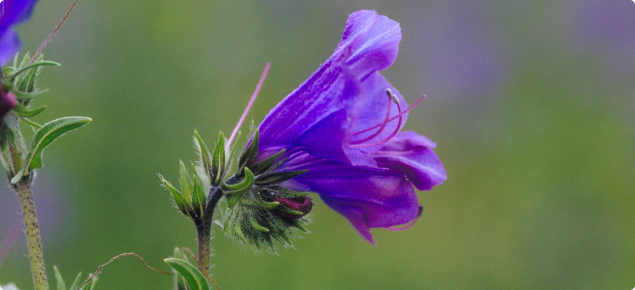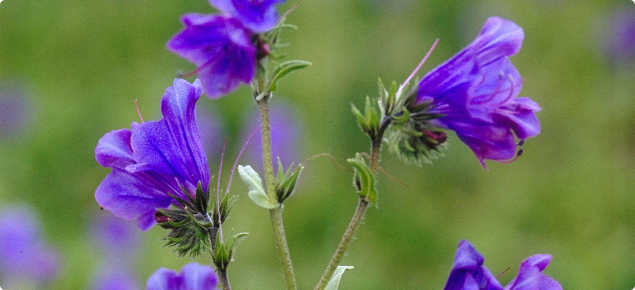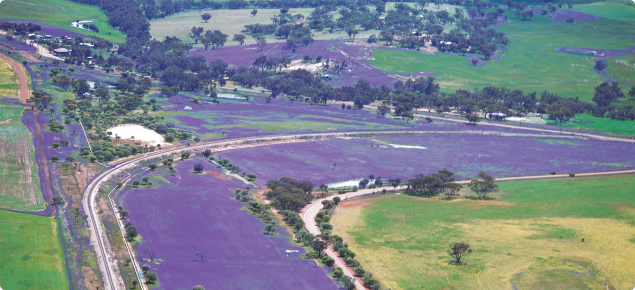Information about this pest can be found on the Paterson’s curse: declared pest page.
Login or set up a new account on DAFWAs online training site to access:
- a training course on how to identify Paterson's curse and report it.
- training material that you can use to teach community groups how to identify Paterson's curse.
Chemical requirements
When using any agricultural chemicals please ensure that you always follow instructions on the label and any permit. Users of agricultural chemical products must always strictly comply with the directions on the label and the conditions of any permit. To view permits or product labels go to the Australian Pesticides and Veterinary Medicines Authority website.
Control options
Chemical control options can be found below. For other methods of prevention (biosecurity) please refer to the Paterson's curse: what you should know page and the attached biological control article.
Chemical control options
| Recommended herbicides | In cerealsChlorsulfuron; Metsulfuron methyl; Triasulfuron; Tigrex; Broadstrike; Jaguar; Bromoxynil + MCPA In pasture, up to four leaf stageJaguar®; Tigrex®; Broadstrike®; Bromoxynil + MCPA At early flowering, seed set controlChlorsulfuron; Metsulfuron methyl; Triasulfuron; Glyphosate + 2,4-D LV ester |
|---|
| Herbicide: 2,4-D amine (Group I) (various trade names: see APVMA link) | |
|---|---|
| Active ingredient |
|
| Rates of dilution for spot spraying | Not recommended |
| Amount of product/10L water | Not recommended |
| Rate of product/ha |
|
| Time of application | 'Spray grazing’, winter - from three weeks after germination |
| Remarks | 'Spray graze’ technique for selective control in pastures |
| More information and other control methods | ‘Spray grazing’ apply low rate (0.75L) of 2,4-D amine (500g/L) or MCPA (1L/ha) and heavy graze at four to six times normal stocking rate from seven to ten days after treatment. Best results in small paddocks 10-20ha. Other formulations of 2,4-D amine are available and if using these adjust rates accordingly. |
| Herbicide: Chlorsulfuron (Group B) (various trade names: see APVMA link) | |
|---|---|
| Active ingredient | 750g/kg chlorsulfuron |
| Rates of dilution for spot spraying | 1g/50L |
| Amount of product/10L water | 0.2g |
| Rate of product/ha | 15–20g |
| Wetting agent dilution | 1:400 |
| Time of application |
|
| Remarks |
|
| More information and other control methods | Application of 10–15g/ha at flowering prevents seed formation. Addition of 2,4 –D amine at 10mL/10L or 1L/ha will improve control of seed formation. |
| Herbicide: Metsulfuron methyl (Group B) (various trade names: see APVMA link) | |
|---|---|
| Active ingredient | 600g/kg metsulfuron-methyl |
| Rate of product/ha | 5g |
| Rates of dilution for spot spraying | 0.5g/100L water |
| Wetting agent dilution | 1:400 |
| Time of application |
|
| Remarks | More effective on older plants, that is, August – September |
| More information and other control methods | Addition of 2,4 –D amine @ 1L/ha of 500g/L or 0.8L of 625g/L will improve control of seed formation. |
| Herbicide: Triasulfuron (Group B) (various trade names: see APVMA link) | |
|---|---|
| Active ingredient | 714g/kg triasulfuron |
| Rate of product/ha |
|
| Time of application |
|
| Remarks | For seed set control. Addition of 0.75-1L 2,4-D amine (500g/L) or 0.6 – 0.8L/ha of the 625g/L 2,4-D amine concentration will give a quicker kill of seeds. |
| More information and other control methods |
|
| Herbicide: Glyphosate + 2,4-D LV ester (various trade names: see APVMA link) | |
|---|---|
| Active ingredient |
Other concentrations of glyphosate are available. Adjust rates if using them. |
| Amount of product/10L water |
+ 5mL LV ester |
| Rate of product/ha |
+ 500mL of 2,4-D LV ester |
| Time of application | At early flowering |
| Remarks | Where Paterson's curse is growing in drains or near water courses the herbicide Roundup Biactive® should be used. An APVMA permit is required to apply 2,4-D ester (80%) from 1 September until 1 May. Alternative formulations of 2,4-D are available to substitute the 80% formulation. Rates should be adjusted for the different formulations. |
| More information and other control methods | Glyphosate is suitable for spot spraying in non-selective situations. Care should be taken to check for restricted spraying permits when applying 2,4-D ester. This treatment is only suitable in cereal growing areas where there are no commercial vineyards or tomato gardens. |
| Herbicide: Jaguar® | |
|---|---|
| Active ingredient | 250g/L bromoxynil (Group C) + 25g/L diflufenican (Group F) |
| Rate of product/ha | 500-750mL/ha |
| Time of application | Lower rate for plants with less than two leaves, higher rates for plants with up to four leaves |
| Remarks | Registered in cereals and pastures, including cover crops in vineyards |
| More information and other control methods | Similar product Barracuda registered @ 600mL for small Paterson’s curse |
| Herbicide: Tigrex® | |
|---|---|
| Active ingredient | 250g/L MCPA (Group I) + 25g/L diflufenican (Group F) |
| Rate of product/ha | 1L/ha |
| Time of application | Up to four leaf stage |
| Remarks | Clovers should have three trifoliate leaves |
| More information and other control methods | Some yellowing of clovers may occur. Check label for tolerance of various clovers. |
| Herbicide: Broadstrike® (Group B) | |
|---|---|
| Active ingredient | 800g/kg flumetsulam |
| Rate of product/ha | 25g/ha |
| Wetting agent dilution | 1:400 BS 1000 or Uptake® at 500mL/100L |
| Remarks | Safe on clovers. Appears more effective in the south west. Clovers should have three trifoliate leaves. Paterson’s curse around metro areas has developed resistance to this herbicide as well as the sulfonyl areas. |
| More information and other control methods | Restrictions on grazing or cutting for stockfeed as follows:
|



